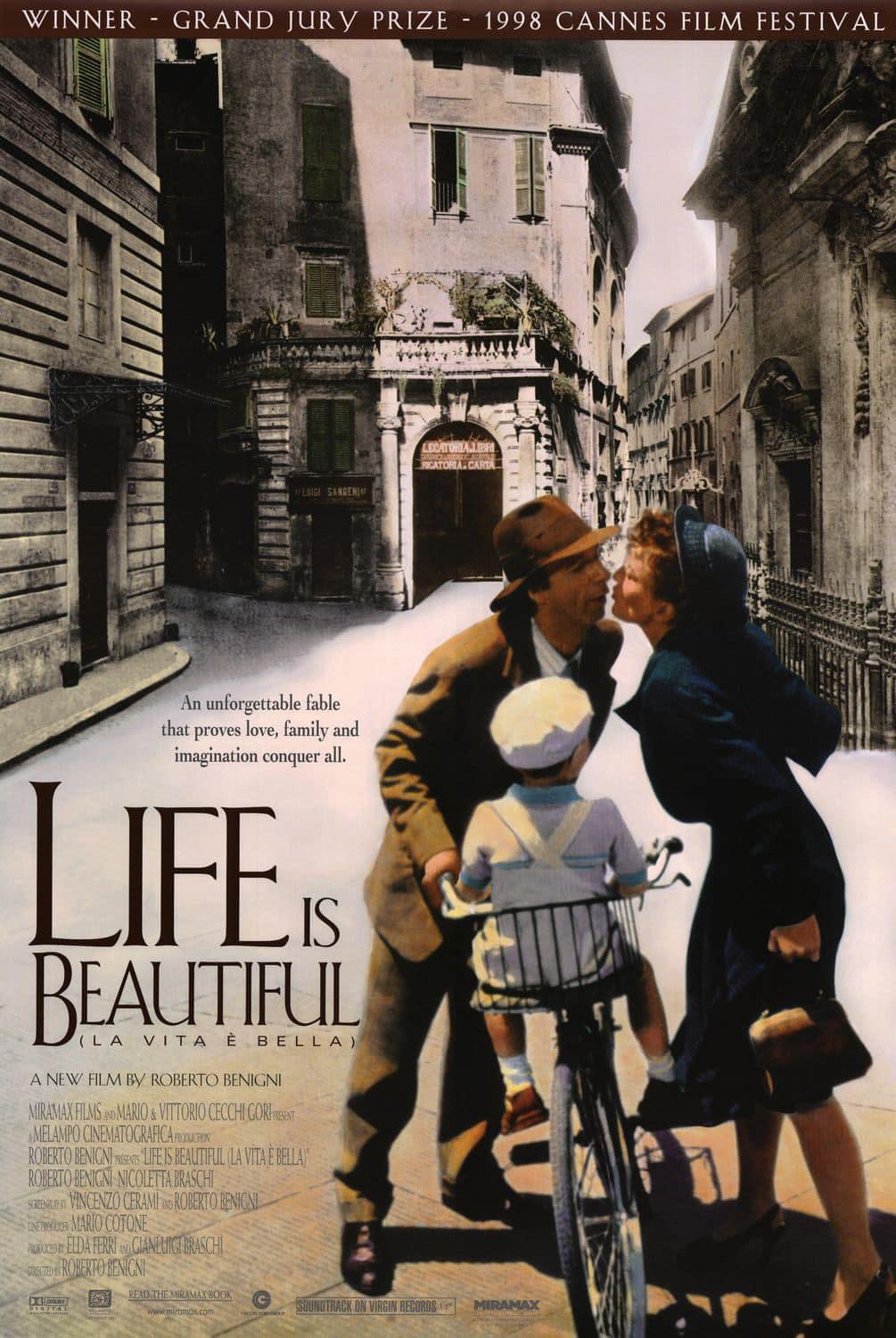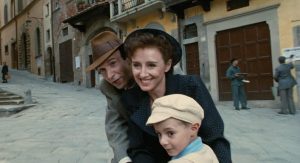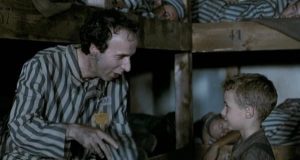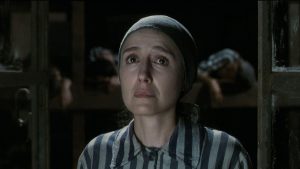La vita è bella (1997)

La vita è bella (Life is Beautiful), directed by and starring Roberto Benigni, is an Italian film from 1997 that merges the beauty of human love and resilience with the harrowing reality of the Holocaust. Known for its blend of comedy and tragedy, this unforgettable film follows the journey of Guido Orefice, an optimistic Jewish Italian, as he navigates life before and during World War II. Balancing humor, romance, and sorrow, the film explores how far a parent will go to shield their child from horror and preserve hope in the bleakest of circumstances.
Suggested videos for you:
Plot Overview
La vita è bella is divided into two distinct parts. The first half introduces Guido Orefice (Roberto Benigni), a lively and playful man who arrives in a small Tuscan town, full of dreams and infectious charm. Guido’s boundless optimism leads him to pursue Dora (Nicoletta Braschi), a schoolteacher who is unhappily engaged to a pompous local official. Through a series of humorous, romantic gestures, Guido wins Dora’s heart, and they marry and have a son named Giosuè (Giorgio Cantarini).
However, the tone of the film changes dramatically in the second half as the family is captured and taken to a Nazi concentration camp. Faced with the horrific reality of the camp, Guido concocts an elaborate “game” to protect his son from the trauma. He convinces Giosuè that they are playing a contest, where following specific rules will earn them points toward winning a real army tank. This “game” becomes Guido’s way of shielding his son’s innocence and keeping him hopeful, even as they endure unimaginable hardships.
Themes and Messages
The film is deeply thematic, with messages of love, resilience, sacrifice, and the transformative power of imagination. At its core, La vita è bella is a love story, not only between Guido and Dora but, more importantly, between Guido and his son. Guido’s playful deception in the camp is driven by an overwhelming desire to protect Giosuè from the horrors surrounding them, showing the lengths a parent will go to preserve a child’s innocence.
One of the film’s most profound messages is the idea of resilience and hope. Despite being thrust into the darkest of circumstances, Guido remains determined to find joy and maintain a sense of normalcy for his son. The “game” he creates becomes a means of survival, both psychologically and emotionally, highlighting how humor and love can act as shields against suffering.
The film also explores themes of human dignity and moral strength. Guido’s unbreakable spirit represents a defiance of dehumanization. He refuses to let his spirit be broken by the Nazis, instead choosing to live for his son and make each moment meaningful. His creativity and sense of humor become acts of resistance, preserving his identity and love even in a place designed to strip humanity away.
Characters and Performances
Roberto Benigni’s portrayal of Guido Orefice is masterful and unforgettable. Known as a comedian, Benigni brings his natural humor and physical comedy to the role, especially in the first half of the film, where Guido’s playful antics and wide-eyed optimism endear him to both Dora and the audience. However, it is in the second half of the film that Benigni’s range shines, as he balances Guido’s humor with a deep, quiet desperation. His performance captures Guido’s intense love for his son, as well as his own inner turmoil, as he risks everything to keep Giosuè safe and unaware of their grim reality. The humor, tenderness, and sorrow that Benigni brings to the character of Guido make it one of the most powerful performances in recent film history.
Nicoletta Braschi, as Dora, brings a quiet strength to her role. Although Dora has a smaller role in the story, her character adds a layer of emotional depth. Her decision to join her husband and son on the train to the concentration camp, despite being allowed to remain free, demonstrates her love and solidarity. Braschi’s performance is understated, capturing Dora’s love and resilience without overshadowing the central father-son dynamic.
Young Giorgio Cantarini, as Giosuè, is remarkable in his role. He brings an innocence and trust that make Guido’s efforts to protect him all the more poignant. Giosuè’s belief in his father’s “game” amplifies the film’s emotional impact, as the audience understands the reality he cannot see.
Cinematography and Visual Style
The cinematography of La vita è bella by Tonino Delli Colli complements the film’s emotional journey, using distinct visual shifts to reflect the change in tone from the first to the second half. The first half is filled with vibrant, warm colors, reflecting Guido’s joyful personality and his hopeful view of life. The Italian countryside and town settings are full of life and charm, mirroring Guido’s dreams and the romantic fairytale quality of his courtship with Dora.
Once the story moves to the concentration camp, the color palette becomes stark and muted, with gray tones dominating the screen. This visual contrast emphasizes the brutality of the setting and the drastic shift in Guido’s life. The confinement and coldness of the camp setting are reinforced by the cinematography, with cramped spaces and harsh lighting that underscore the isolation and danger Guido faces while keeping up his ruse.
Use of Humor in Tragedy
One of the most challenging and unique aspects of La vita è bella is its use of humor in such a tragic context. Roberto Benigni’s approach to the Holocaust through comedy was initially met with skepticism and concern. However, the film’s humor is not meant to trivialize the suffering of Holocaust victims; instead, it serves as a tool of resistance and survival. By creating a “game” for his son, Guido transforms a nightmarish reality into something bearable. The humor is always directed at maintaining hope, not making light of the horrors around them.
This approach to comedy in tragedy aligns with the tradition of “gallows humor,” where people find solace in humor amidst suffering. Benigni’s humor in the film highlights humanity’s ability to find light in the darkest of times and shows that even when faced with oppression, people can still assert their dignity and love through laughter.
Criticisms and Controversy
While La vita è bella was widely acclaimed, it also faced criticism and controversy for its approach to depicting the Holocaust. Some critics argued that using humor in such a serious setting risked undermining the historical gravity of the Holocaust, and that the film’s approach could be seen as overly sentimental. Others felt that the story’s simplicity might inadvertently gloss over the atrocities experienced by victims. However, many Holocaust scholars and survivors defended the film, appreciating it as a work of art that humanizes the suffering of that period while preserving the dignity of those affected.
Ultimately, La vita è bella is not a traditional Holocaust film; it does not seek to show the full scope of the horrors, but rather focuses on a personal, intimate story of one father’s love for his child. It’s a fable-like narrative that uses humor and imagination to offer a unique perspective on a harrowing historical tragedy.
Legacy and Conclusion
La vita è bella remains a beloved film for its emotional depth, unforgettable performances, and unique perspective on resilience. It received critical acclaim, winning three Academy Awards, including Best Actor for Benigni, who famously accepted the award with unbridled joy. The film’s universal themes of love, sacrifice, and resilience have allowed it to resonate with audiences around the world, even those far removed from the specific history it portrays.
While it may not serve as a comprehensive or traditional Holocaust narrative, La vita è bella offers a profound look at the power of human kindness and imagination. By using humor and fantasy to protect his son, Guido creates a legacy of love and hope that endures even in tragedy. In this way, La vita è bella affirms that life, no matter how difficult or painful, is indeed beautiful when lived with love, compassion, and courage.











